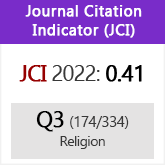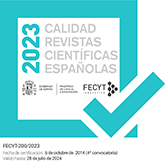What Sort of Information does the Midrash Transmit about the Synagogue? Some Reflections from Leviticus Rabbah
DOI:
https://doi.org/10.3989/sefarad.018.008Keywords:
Synagogue, Midrash, Leviticus RabbahAbstract
This study focuses on the accounts transmitted in Lev. Rab about the synagogue in late antique Palestine. The aim is two-fold: 1) to determine the kind of information about the synagogue according to Lev. Rab related to both the building and other associated features, and liturgical, educational and communal data, and 2) to highlight the difficulties inherent in evaluating this information, especially taking into consideration the scarcity of contextual details. This study, then, contributes to the discussion about the connection between the synagogue and the Midrash, shedding light on the perspective of the rabbis regarding this institution in amoraic times and their degree of involvement in synagogue life.
Downloads
References
Avi-Jonah, Michael (2007): "Hammath," in Fred Skolnik and Michael Berenbaum (eds.), EncJud 2ed., vol. 8 (Detroit: Thomson Gale –Jerusalem: Keter Publishing House) pp. 306-307.
Bird, Frederick B. (1982): "A Comparative Study of the Work of Charity in Christianity and Judaism," The Journal of Religious Ethics 10:1, pp. 144-169.
Bloedhorn, Hanswulf and Gil Hüttenmeister (1999): "The Synagogue," in William Horbury, W. D. Davies and John Sturdy (eds.), The Cambridge History of Judaism, III: The Early Roman Period (Cambridge: Cambridge University Press) pp. 267-297.
Brettler, Marc Z. (2017): "Judaism, Bible in, I. Judaism" in Encyclopedia of the Bible and Its Reception, vol. 14 (Berlin–Boston: Walter de Gruyter) pp. 902-919.
Cohen, Shaye J. D. (1999): "The Temple and the Synagogue," in William Horbury, W. D. Davies and John Sturdy (eds.), The Cambridge History of Judaism, III: The Early Roman Period (Cambridge: Cambridge University Press) pp. 298-325.
Fine, Steven (1997): This Holy Place. On the Sanctity of the Synagogue during the Greco-Roman Period (Notre Dame, Indiana: University of Notre Dame Press).
Gafni, Isaiah (2007): "Rabbinic Historiography and Representations of the Past," in Charlotte E. Fonrobert and Martin S. Jaffee (eds.), The Cambridge Companion to the Talmud and Rabbinic Literature (Cambridge: Cambridge University Press) pp. 295-312. https://doi.org/10.1017/CCOL0521843901.014
Gardner, Gregg E. (2015): The Origins of Organized Charity in Rabbinic Judaism (New York: Cambridge University Press).
Hengel, Martin and Anna M. Schwemer (1997): Paul Between Damascus and Antioch. The Unknown Years (London: SCM).
Hezser, Catherine (2001): Jewish Literacy in Roman Palestine (= Texts and Studies in Ancient Judaism, 81 [Tübingen: Mohr Siebeck]).
Hezser, Catherine (1997): The Social Structure of the Rabbinic Movement in Roman Palestine (= Texts and Studies in Ancient Judaism, 66 [Tübingen: Mohr Siebeck]).
Hirshman, Marc (1991): "The Preacher and his Public in Third-Century Palestine," Journal of Jewish Studies 42:1, pp. 108-114.
Hirshman, Marc (2006): "Torah in Rabbinic Thought: The Theology of Learning," in Steven T. Katz (ed.), The Cambridge History of Judaism, IV: The Late Roman-Rabbinic Period (Cambridge: Cambridge University Press) pp. 899-924.
Jastrow, Marcus (1926): Dictionary of Targumim, Talmud, and Midrashic Literature, pp. 1243-1244 (Tyndale Archive of Biblical Studies, http://www.tyndalearchive.com/tabs/jastrow/).
Kimelman, Reuven (2006): "Rabbinic Prayer in Late Antiquity," in Steven T. Katz (ed.), The Cambridge History of Judaism, IV: The Late Roman-Rabbinic Period (Cambridge: Cambridge University Press) pp. 573-611.
Kraemer, David (2000): The Meanings of Death in Rabbinic Judaism (London–New York: Routledge).
Kraemer, David (2016): Rabbinic Judaism. Space and Place (Routledge Jewish Studies Series; London–New York: Routledge).
Levine, Lee I. (2000): Ancient Synagogue: The First Thousand Years. Second Edition (New Haven–London: Yale University Press) p. 180.
Mandel, Paul D. (2017): The Origins of the Midrash. From Teaching to Text (Supplements to the Journal for the Study of Judaism 180; Leiden–Boston: Brill).
Margulies, Mordechai (1953-1960): Midrash Wayyikra Rabbah: A Critical Edition Based on Manuscripts and Genizah Fragments with Variants and Notes, 2 vols. (New York–Jerusalem: The Maxell Abbell Publication Fund–The Jewish Theological Seminary of America, 1993 [Jerusalem]).
Milikowsky, Chaim and Margarete Schlüter, Synoptic Edition of Wayyiqra Rabbah, http://www.biu.ac.il/JS/midrash/VR/about.htm.
Miller, Stuart S. (1998): "On the Number of Synagogues in the Cities of ʾErez Israel," Journal of Jewish Studies 49:1, pp. 51-66.
Miller, Stuart S. (1999): "The Rabbis and the Non-Existent Monolithic Synagogue," in Steven Fine (ed.), Jews, Christians, and Polytheists in the Ancient Synagogue. Cultural Interaction during the Greco-Roman Period (London–New York: Routledge) pp. 57-70.
Miralles-Maciá, Lorena (2009): "Motivos filo-esópicos en el Midrás. Fábulas y anécdotas de rabinos en Levítico Rabbá 22,4," Sefarad 69:2, pp. 281-302.
Neusner, Jacob (1997): The Components of the Rabbinic Documents. From the Whole to the Parts. X: Leviticus Rabbah, 3 vols. (Academic Commentary Series; Atlanta: Scholars Press).
Porton, Gary G. (2002): "Rabbinic Midrash Public or Private," Review of Rabbinic Judaism 5:2, pp. 141-169.
Porton, Gary G. (2004): "Midrash and the Rabbinic Sermon," in Alan J.Avery-Peck, Daniel Harrington and Jacob Neusner (eds.), When Judaism & Christianity Began: Essays in Memory of Anthony J. Saldarini, vol. II (= Supplements to the Journal for the Study of Judaism, 85 [Leiden: Brill]) pp. 461-482.
Porton, Gary G. (2005): "Midrash, Definitions of," in Jacob Neusner and Alan Avery-Peck (eds.), Encyclopedia of Midrash (Leiden: Brill) pp. 520-34.
Posner, Raphael (2007): "Charity. In the Talmud and Rabbinic Literature," in Fred Skolnik and Michael Berenbaum (eds.), EncJud 2ed., vol. 4 (Detroit: Thomson Gale – Jerusalem: Keter Publishing House) pp. 569-571.
Rabinowitz, Louis I. (2007): "Synagogue. Origins and History. First Century C.E.," in Fred Skolnik and Michael Berenbaum (eds.), EncJud 2ed., vol. 19 (Detroit: Thomson Gale – Jerusalem: Keter Publishing House) pp. 354-355.
Reif, Stefan C. (1999): "The Early Liturgy of the Synagogue," in William Horbury, W. D. Davies and John Sturdy (eds.), The Cambridge History of Judaism, III: The Early Roman Period (Cambridge: Cambridge University Press) pp. 326-357.
Rosenfeld, Ben-Zion and Joseph Menirav (1999): "The Ancient Synagogue as an Economic Center," Journal of Near Eastern Studies 58:4, pp. 259-276.
Rosenfeld, Ben-Zion and Joseph Menirav (2005): Markets and Marketing in Roman Palestine (Supplements to JSJ 99; Leiden: Brill).
Samely, Alexander (2010): "Literary Structures and Historical Reconstruction: The Example of an Amoraic Midrash (Leviticus Rabbah)," Proceedings of the British Academy 165, pp. 185-215.
Schwartz, Seth (2001): Imperialism and Jewish Society, 200 B.C.E. to 640 C.E. (Jews, Christians, and Muslims from the Ancient to the Modern World; Princeton–Oxford: Princenton University Press).
Sherman, Miriam (2006): A Well in Search of an Owner: Using Novel Assertions to Assess Miriam's Disproportionate Elaboration among Women in the Midrashim of Late Antiquity (UC San Diego Electronic Theses and Dissertations, eScholarships University California, https://escholarship.org/uc/item/9zx60786).
Shinan, Avigdor (1987): "Sermons, Targums, and the Reading from Scriptures in the Ancient Synagogues," in Lee I. Levine (ed.), The Synagogue in Late Antiquity (Philadelphia) pp. 97-110.
Shinan, Avigdor (2006): "The Late Midrashic, Paytanic, and Targumic Literature", in Steven T. Katz (ed.), The Cambridge History of Judaism, IV: The Late Roman-Rabbinic Period, (Cambridge University Press) pp. 678-698. https://doi.org/10.1017/CHOL9780521772488.029
Sokoloff, Michael (1990): A Dictionary of Jewish Palestinian Aramaic of the Byzantine Period (Dictionaries of Talmud. Midrash and Targum 2; Ramat-Gan: Bar Ilan University Press).
Stemberger, Günter (2008): "The Derashah in Rabbinic Times," in Alexander Deeg, Walter Homolka and Heinz Günther Schöttler (eds.), Preaching in Judaism and Christianity: Encounters and Developments from Biblical Times to Modernity (Berlin: Walter de Gruyter) pp. 7-21.
Stemberger, Günter (2010): "The Derashah in Rabbinic Times," in Judaica Minora. Teil II: Geschichte und Literatur des rabbinischen Judentums (= Texts and Studies in Ancient Judaism, 138 [Tübingen: Mohr Siebeck]) pp. 663-675.
Stemberger, Günter (2009): Das klassische Judentum. Kultur und Geschichte der rabbinischen Zeit (München: C. H. Beck).
Stemberger, Günter (2011): Einleitung in Talmud und Midrasch (München: C. H. Beck).
Strack, Hermann L. and Günter Stemberger (1996): Introduction to the Talmud and Midrash (trans. Markus Bockmuehl. Minneapolis: Fortress Press).
Visotzky, Burton L. (2011): "The Misnomers "Petihah" and "Homiletic Midrash" as Descriptions for Leviticus Rabbah and Pesikta De-Rav Kahana," Jewish Studies Quarterly 18, pp. 19-31.
Visotzky, Burton L. (2003): Golden Bells and Pomegranates: Studies in Midrash Leviticus Rabbah (= Texts and Studies in Ancient Judaism, 94 [Tübingen: Mohr Siebeck]).
Ulmer, Rivka and Moshe Ulmer (2014): Righteous Giving to the Poor: Tzedakah ("Charity") in Classical Rabbinic Judaism. Including a Brief Introduction to Rabbinic Literature (Gorgias Handbooks. Piscataway, NJ: Gorgias Press).
Downloads
Published
How to Cite
Issue
Section
License
Copyright (c) 2019 Consejo Superior de Investigaciones Científicas (CSIC)

This work is licensed under a Creative Commons Attribution 4.0 International License.
© CSIC. Manuscripts published in both the printed and online versions of this Journal are the property of Consejo Superior de Investigaciones Científicas, and quoting this source is a requirement for any partial or full reproduction.All contents of this electronic edition, except where otherwise noted, are distributed under a “Creative Commons Attribution 4.0 International” (CC BY 4.0) License. You may read here the basic information and the legal text of the license. The indication of the CC BY 4.0 License must be expressly stated in this way when necessary.
Self-archiving in repositories, personal webpages or similar, of any version other than the published by the Editor, is not allowed.














